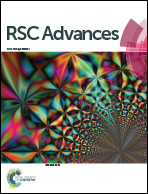A systematic investigation on the interaction of l-cysteine functionalised Mn3O4 nanoparticles with lysozyme
Abstract
Biological interactions of magnetic nanoparticles have attracted enormous interest because of their wide applications in medical diagnostics, imaging, and biosensors. Mn3O4 nanoparticles are potentially significant among magnetic nanoparticles and have not yet been investigated for their interactions with proteins. Here we report a systematic investigation of the interactions between hen egg white lysozyme and L-cysteine functionalised Mn3O4 nanoparticles using calorimetric and spectrophotometric techniques. The L-cysteine functionalised nanoparticles were synthesized by a simple chemical precipitation method and characterized by X-ray diffraction, FTIR, HRTEM, UV-Vis absorption and fluorescence spectroscopy. Mn3O4 nanoparticles are in the tetragonal phase with an average size of 10 nm. Thermodynamic parameters, the binding constant and the number of binding sites associated with the interactions were studied using Isothermal Titration Calorimetry (ITC). Quenching of lysozyme fluorescence is observed upon complex formation with Mn3O4 nanoparticle and the time resolved fluorescence measurements confirm static quenching. The Circular Dichroism (CD) spectra reveal minor alterations in the secondary structure of lysozyme in the complex indicating that Mn3O4 nanoparticles are potential candidates for therapeutic applications.


 Please wait while we load your content...
Please wait while we load your content...